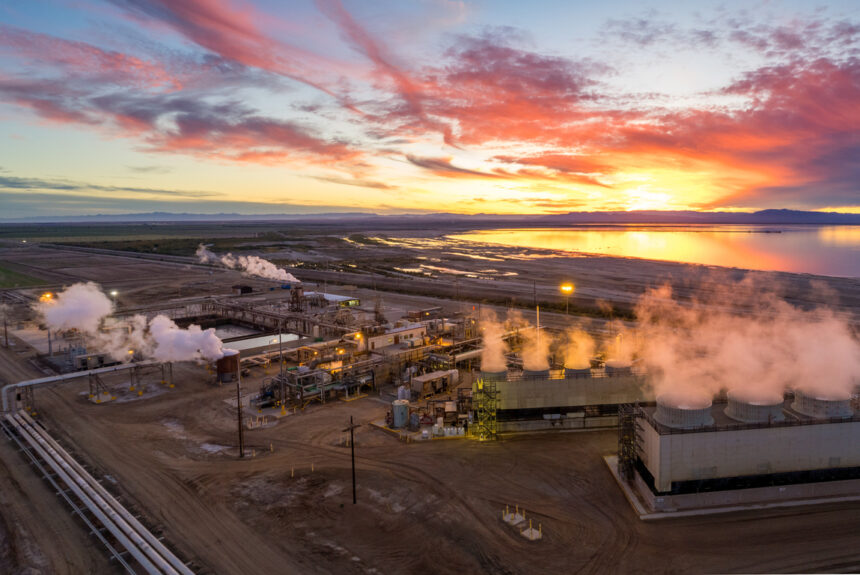Geothermal energy accounts for only 0.4 percent of America’s electricity generation, but technological advancements could significantly change that. A new map shows just how vast geothermal potential as a clean, dependable electricity source worldwide can be.
A tool developed by the non-profit Project InnerSpace in collaboration with Google, GeoMap™ shows complex surface and subsurface mapping to help assess the prospective for enhanced geothermal systems (EGS). EGS, or super hot rock geothermal energy, is a way of tapping into the Earth’s heat deep beneath the surface to generate electricity.
>>>READ: A Welcome Step to Ease Geothermal Permitting on Federal Land
Unlike traditional geothermal energy, which relies on naturally occurring pockets of hot water or steam close to the Earth’s surface, EGS goes much deeper. It involves drilling deep into the Earth’s crust, often several miles down, where the rock is really hot but not necessarily in contact with water. After drilling a well, companies pump water into the hot rock. As the water travels through fractures and cracks in the rock, it gets heated up to extremely high temperatures, where it becomes supercritical. Super-hot steam is then brought back up to the surface through a production well and used to drive turbines connected to generators, producing electricity. While drilling to such depths is technologically and economically challenging, several innovative companies are finding ways to improve the process.
Built by a team of scientists and researchers across several universities, the map provides detailed subsurface data on the depth of the heat source, the heat flow, seismicity, and many other details. Surface level mapping shows building level data, which can be useful for developers when thinking about demand potential, transmission, availability, and environmentally sensitive areas.
Project InnerSpace created GeoMap™ as “a rising tide lifts all boats” for the geothermal sector, noting that the resource could also prove useful for the critical minerals and hydrogen industries. GeoMap™ will better inform investors and project developers but also the public and policymakers. As is the concern with many innovative technologies, outdated policies and regulations could stifle geothermal energy’s progress.
Several policy reforms could improve the economic outlook for geothermal energy. In March, Senators Jim Risch (R-ID) and Martin Heinrich (D-NM), with Senators Mike Lee (R-UT) and Catherine Cortez Masto (D-NV), introduced the Geothermal Energy Optimization (GEO) Act. The bill would create categorical exclusions for National Environmental Policy Act reviews for geothermal exploration activities, putting it on equal footing with oil and gas exploration. Policymakers could go even further by creating categorical exclusions for geothermal production as opposed to just exploration activities. The bill would also make it easier to deploy geothermal on federal lands by requiring the Bureau of Land Management to hold lease auctions annually and provide more resources to process permits more efficiently.
Members in the House of Representatives have also introduced several notable reforms to boost geothermal development. Representative Young Kim (R-CA) introduced the Harnessing Energy at Thermal Sources (HEATS) Act. The bill would ensure that no federal permit is necessary for geothermal projects on state and private lands, underscoring that state environmental requirements are sufficient for public health and safety. Rep. Michelle Steel (R-CA) and Rep. Susie Lee (D-NV) proposed legislation that would amend the Energy Policy Act to create a more efficient permitting process for geothermal projects on previously studied or developed areas.
>>>READ: Geothermal Development and Policy HEATs Up
More recently, Science and Technology Committee Chair Frank Lucas (R-OK) and Rep. Andrea Salinas (D-OR) introduced the Supercritical Geothermal Research and Development Act. The legislation would support research, development, and demonstration activities for superhot rock geothermal and closed-loop geothermal in supercritical conditions.
The potential for geothermal around the world is massive. As evidenced by these bills, the bipartisan support for geothermal energy is strong in both chambers, and the private sector is advancing technologies to scale up while lowering costs. Project InnerSpace’s GeoMap™ will be an essential resource for the acceleration of geothermal energy as a clean, reliable energy source across the globe.
The views and opinions expressed are those of the author’s and do not necessarily reflect the official policy or position of C3.
